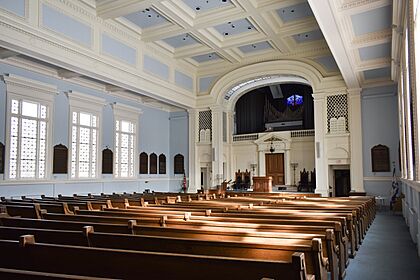Temple Society of Concord facts for kids
Quick facts for kids Temple Society of Concord |
|
|---|---|

Interior of the synagogue's sanctuary in 2019
|
|
| Religion | |
| Affiliation | Reform Judaism |
| Ecclesiastical or organisational status | Synagogue |
| Leadership | Rabbi Ilan Emanuel Cantor Kari Siegel Eglash |
| Status | Active |
| Location | |
| Location | 450 Kimber Road, Syracuse, Onondaga County, New York 13224 |
| Country | United States |
| Architecture | |
| Architect(s) |
|
| Architectural type | Synagogue |
| Architectural style | Neo-classical |
| Date established | 1839 (as a congregation) |
| Completed | 1911 |
| Construction cost | $100,000 |
| Materials | Limestone |
The Temple Society of Concord, often called Temple Concord, is a Jewish place of worship, or synagogue, in Syracuse, New York. It follows the Reform branch of Judaism.
It was started way back in 1839, making it one of the oldest Jewish groups still active in the United States. Temple Concord is a big part of the Jewish community in Central New York. It has the largest Jewish religious school in the area. People gather for religious services every Friday night and Saturday morning, and on Jewish holidays. The synagogue also hosts many educational, cultural, and social events for the whole Syracuse community.
The synagogue building was added to the list of important historical places in 2009. In 2019, the group decided to sell the building because of money challenges.
Contents
How Temple Concord Started
Temple Concord was founded in 1839 by German immigrants. These new arrivals came to upstate New York because of the new Erie Canal. The canal made it easier to travel and move goods.
At first, the small group met in a back room of a local store. By 1841, they moved to the second floor of a member's home. They hired their first religious leader, who was not a formally trained rabbi. The group officially became a recognized organization in New York State on February 24, 1842. They first called themselves "Comrades of Peace." Soon after, they changed their name to Keneseth Shalome, which they translated as Temple Society of Concord.
Religious Leaders of Temple Concord
In its early years, many different religious leaders served the congregation. These leaders were often called "Reverends." They performed many roles, like leading songs (cantors), teaching, and performing important Jewish rituals. Most of them were not formally trained as rabbis.
Rabbi Adolph Guttman, who came from Austria, was the first modern Reform rabbi for the temple. He helped shape how services were held and how the organization worked for many years.
Past and Present Leaders
- Abraham Gunzenhauser (1841-1846)
- Joseph Goodman
- Jacob Levi
- Bernard Illowy
- Herman Berkenthal
- Rev. Deutsch
- Rev. Cohen
- Rev. Burgheimer
- Dr. Adolph Guttman (1883-1918)
- Rabbi Benjamin Friedman (1919-1969)
- Rabbi Theodore S. Levy (1970-1990)
- Rabbi Sheldon Ezring (1990-2009)
- Rabbi Daniel Fellman (2009-2021)
- Rabbi Ilan Emanuel (2021-present)
The Synagogue Buildings
In 1851, the congregation built its very first synagogue building. It was located at Harrison and Mulberry Streets. This building cost $10,000, which was a lot of money back then.
The current synagogue building is at Madison Street and University Avenue. It was designed in a Neo-classical style. This style looks like ancient Greek and Roman buildings. The main architect was Alfred Taylor, with Arnold W. Brunner as a consultant. The first stone was laid on September 19, 1910. The building was officially opened on September 23, 1911. It cost $100,000 to build.
In the 1920s, a social hall was made bigger, and a classroom building was added. The Hiram and Mabel Weisberg Religious School was built in 1961. It was designed by Edward C. Roock.
A special prayer room, the Benjamin M. Berinstein Memorial Chapel, was built in 1997. It was placed inside the old 1920s education building. A member of the congregation, Allen Kosoff, was the architect. John Dobbs designed the beautiful stained glass windows.
The 1910-11 building was recognized as a historic place on April 27, 2009. In July 2019, the members voted to sell the building. This was due to fewer members and financial challenges. The plan was to turn it into student housing. The first plans were changed because some people felt the new building would be too big. A new plan was submitted in 2021, proposing 210 apartments.
Gallery
See also
- Ethnic groups in Syracuse, New York
- List of the oldest synagogues in the United States
- Louis Marshall








